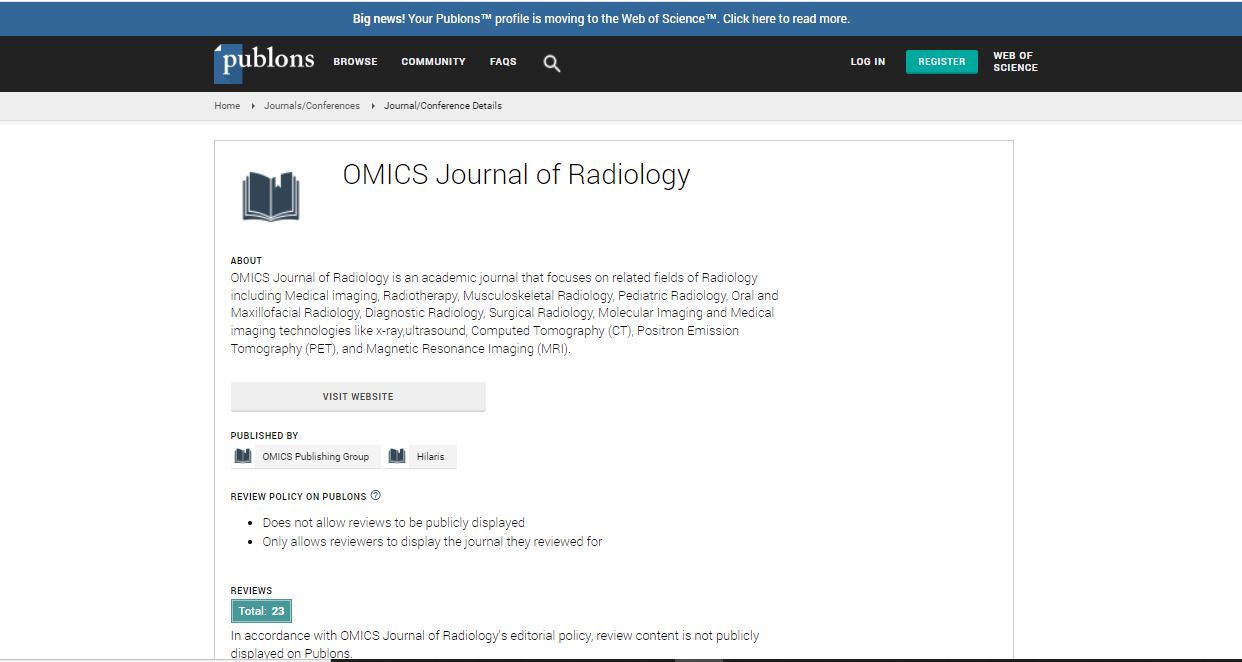Our Group organises 3000+ Global Conferenceseries Events every year across USA, Europe & Asia with support from 1000 more scientific Societies and Publishes 700+ Open Access Journals which contains over 50000 eminent personalities, reputed scientists as editorial board members.
Open Access Journals gaining more Readers and Citations
700 Journals and 15,000,000 Readers Each Journal is getting 25,000+ Readers
Google Scholar citation report
Citations : 551
Journal of Radiology received 551 citations as per Google Scholar report
Journal of Radiology peer review process verified at publons
Indexed In
- Index Copernicus
- Google Scholar
- Open J Gate
- Genamics JournalSeek
- ResearchBible
- Electronic Journals Library
- RefSeek
- Hamdard University
- EBSCO A-Z
- OCLC- WorldCat
- SWB online catalog
- Virtual Library of Biology (vifabio)
- Publons
- Geneva Foundation for Medical Education and Research
- ICMJE
Useful Links
Share This Page
Cerebral venous dynamics change as potential indication of cerebral aneurysmal rupture
2nd International Conference on Neuroscience, Neuroimaging & Interventional Radiology
Kwo-Whei Lee
Chang-Hua Christian Hospital, Taiwan Taipei Medical University, Taiwan
ScientificTracks Abstracts: OMICS J Radiol
Abstract
Introduction: Many inconsistent etiologies of cerebral aneurysmal rupture including a wide spectrum of factors have been reported. Our recent observation discloses the potential new factor of cerebral aneurysm rupture with cerebral venous pressure gradient. Materials and Methods: We retrospectively reviewed 25 cases treated with coil embolization with or without cerebral aneurysmal rupture. Seven males and 18 females were recruited in this study. The age ranging from 49 to 71 and average being 59.Quantitative color-coded cerebral angiography was performed during coil therapeutic procedures to measure cerebral venous circulation. Result and Conclusion: Ruptured cases had shorter and symmetrical cerebral venous circulation time (P <0.05). In addition, an asymmetrical venous outflow pattern was critical for aneurysmal rupture as seen in case 1. Non-ruptured cases tended to have slower and asymmetrical cerebral venous circulation compared with rupture cases as seen case 2. Symmetrical and shorter cerebral venous circulation in the epislateral dysplasia venous outlet may be a potential new factor for cerebral aneurysm rupture. An asymmetrical venous outflow pattern was critical for managing cerebral aneurysm and determines aneurysmal rupture. Illustrative Case: Case 1: A 50 year old male presented with acute anterior communicating saccular aneurysm ruptured and treated by endovascular coiling immediately post Dyna CT study. He discharged without any sequelae but still just mild headache. The venous phase showed atresia of left dural venous sinus, right dural venous sinus is dominated venous drainage but there is symmetrical venous flow. Post-Postcoiling showed the arterial flow had no change but delayed venous flow. This symmetrical venous flow might indicate increasing venous pressure gradient. Case2: A 64 year old female had asymptomatic non-ruptured Rt distal internal carotid small wide neck saccular aneurysm Result and Conclusion: Cerebral venous circulation time among rupture and non-rupture patients: Non-rupture: Right Ã?Â?CCT:11.32+/-88 Left Ã?Â?CCT:12.49+/-42 Rupture: Right Ã?Â?CCT:11.12+/-1.87 Left Ã?Â?CCT:11.54+/-2.22 Ruptured cases had shorter and symmetrical cerebral venous circulation time (P <0.05). In addition, an asymmetrical venous outflow pattern was critical for aneurysmal rupture as seen in case 1. Non-ruptured cases tended to have slower and asymmetrical cerebral venous circulation compared with rupture cases as seen case 2. Symmetrical and shorter cerebral venous circulation in the epislateral dysplasia venous outlet may be a potential new factor for cerebral aneurysm rupture. An asymmetrical venous outflow pattern was critical for managing cerebral aneurysm and determine aneurysmal rupture.Biography
Kwo-Whei Lee is currently working in Department of Medical Imaging, Vascular and Genomic Research Center, Changhua Christian Hospital; Taipei, Taiwan. He is also engaged in Imaging Research Center, Taipei Medical University; Taipei, Taiwan

 Spanish
Spanish  Chinese
Chinese  Russian
Russian  German
German  French
French  Japanese
Japanese  Portuguese
Portuguese  Hindi
Hindi 
